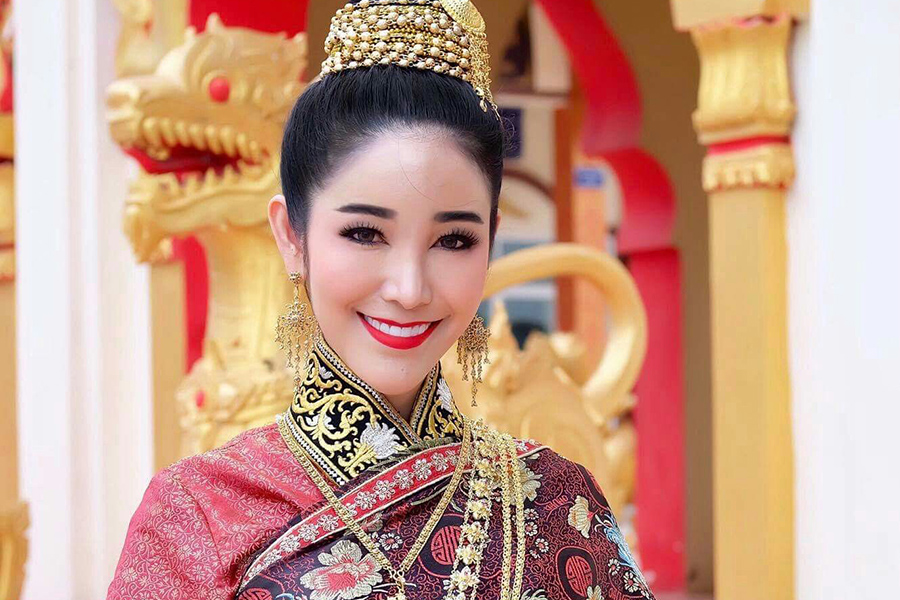In the heart of Southeast Asia lies Laos, a land steeped in ancient traditions and vibrant culture. Among its many treasures, Laotian traditional dress stands out as a testament to the country’s rich heritage and exquisite craftsmanship.
For Lao women, the “Sinh” is a symbol of elegance and grace. This tube skirt, typically made of hand-woven silk, flows gracefully around the body, creating a silhouette that is both alluring and sophisticated. The Sinh comes in a myriad of colors and patterns, each with its own unique meaning and symbolism. From the vibrant hues of sunset to the delicate motifs of nature, the Sinh is a canvas upon which Lao women express their individuality and cultural pride.
Lao men, on the other hand, embrace the “Salong,” a loose-fitting garment that reflects their laid-back and comfortable lifestyle. This sarong-like cloth is wrapped around the waist and secured with a knot, creating a versatile ensemble that can be adapted to various occasions. From working in the fields to attending festivals, the Salong is a symbol of Lao men’s practicality and adaptability.
As you set foot in Laos, you’ll be captivated by the sight of Lao people dancing the traditional Lam Vong, their movements synchronized with the rhythm of the music. The dancers twirl and sway, their colorful costumes swirling around them like a symphony of hues. The men’s Salongs flutter gracefully, while the women’s Sinhs shimmer under the light, creating a mesmerizing spectacle.
Laotian traditional dress is more than just clothing; it’s an embodiment of the country’s soul. Each stitch, each pattern, each color tells a story, whispering tales of ancient customs and deep-rooted traditions. As you explore Laos, let your eyes wander over the vibrant tapestry of traditional attire, and you’ll discover a world of beauty, artistry, and cultural richness.
Traditional women’s costumes of Laos
Suea pat – Traditional Dress in Laos
In the heart of Southeast Asia, where vibrant cultures converge, lies a sartorial gem known as the suea pat, a traditional shirt that graces the shoulders of women from diverse ethnicities in Laos and Northern Thailand. This exquisite garment, often adorned with intricate embroidery and shimmering embellishments, is an embodiment of the region’s rich heritage and enduring artistry.
Imagine a symphony of colors and textures, where silk and cotton intertwine to create a canvas of elegance. The suea pat, with its delicate long sleeves and graceful silhouette, drapes over the female form, accentuating every movement with a touch of sophistication. As the wearer moves, the shirt gently sways, revealing glimpses of intricate embroidery or gleaming sequins that sparkle under the sunlight.
Picture the suea pat’s signature element – the front panel that wraps over itself, creating a unique closure. Instead of buttons or clasps, strings gently secure the two panels together, adding a touch of rustic charm to this traditional attire.
In Luang Prabang, Laos, the suea pat takes center stage, adorned with grand golden collars that stand out like halos against the vibrant hues of the fabric. These collars, reminiscent of royalty, elevate the suea pat to a symbol of status and elegance, a testament to the region’s rich history and enduring traditions.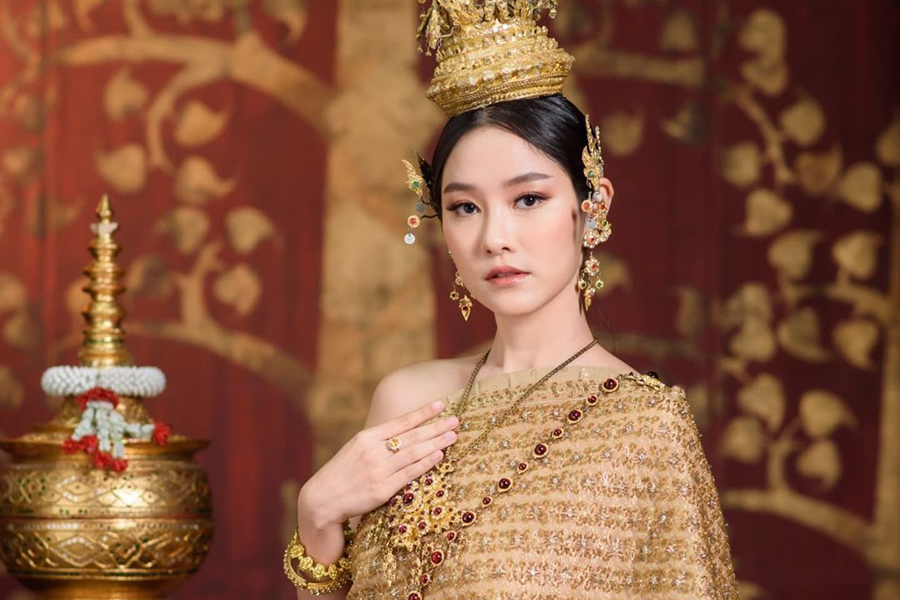
The suea pat is more than just a garment; it’s a cultural emblem, a whisper of ancient customs and deep-rooted traditions. With each stitch, each pattern, each color, the suea pat tells a story, a narrative of the women who wear it, their heritage, and their place within their communities.
As you wander through the bustling markets of Laos and Northern Thailand, let your eyes be captivated by the vibrant tapestry of suea pats on display. Each shirt, a unique masterpiece, speaks volumes about the region’s cultural identity, its love for artistry, and its deep respect for tradition.
Sinh – Traditional Dress in Laos
In the heart of Southeast Asia, where the Mekong River gently flows and ancient traditions linger, lies a land where women are revered as the very embodiment of grace and beauty – Laos. Here, amidst the lush greenery and serene landscapes, Laos women embrace their role as the nation’s mothers, carrying within them a legacy of elegance and gentility that shines through in their attire.
As you traverse the bustling villages and sun-drenched fields of Laos, you’ll encounter a sight that encapsulates the essence of Lao womanhood – the humble yet captivating Sinh. This wraparound skirt, crafted from hand-woven silk and cotton, clings gracefully to the female form, its intricate patterns whispering tales of cultural heritage and unspoken strength. The Sinh, in its simplicity, exudes an effortless beauty, mirroring the resilience and unwavering spirit of the Lao women who wear it with pride.
But when the rhythm of life slows down and the air fills with the anticipation of a grand celebration, Laos women transform into a vision of exquisite splendor. Their hair, meticulously coiled and adorned with delicate ornaments, cascades down their backs like a waterfall of midnight silk. A vibrant blouse, its hues mirroring the vibrant hues of the Laotian sunset, embraces their torsos, while silk skirts, shimmering with an otherworldly glow, swirl around their ankles like a symphony of colors.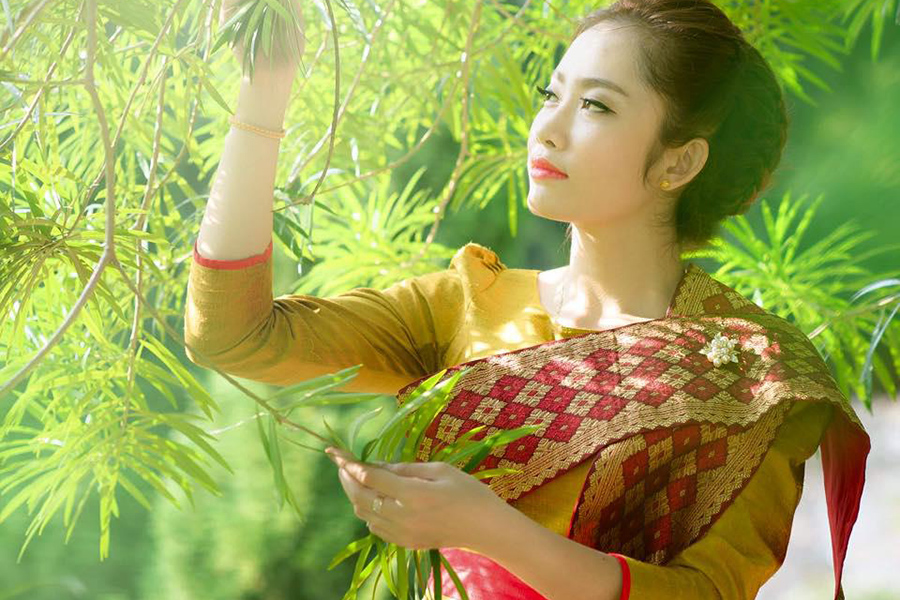
Completing this enchanting ensemble is the pha biang, a shawl-like garment that drapes gracefully over one shoulder, its delicate fabric flowing like a whisper of the wind. The pha biang, in its versatility, can be transformed into a headpiece, a veil, or even a sash, adding an air of mystery and allure to the Lao woman’s already captivating presence.
The traditional Sinh set, comprising the sinh, the suea pat, and the pha biang, is more than just a collection of garments; it’s a testament to the enduring spirit of Lao women, their unwavering connection to their heritage, and their ability to transform from everyday heroines to embodiments of grace and elegance in the blink of an eye.
Pha Biang – A Tapestry of Lao Tradition
In the heart of Laos, where the Mekong River gracefully winds through verdant landscapes, lies a sartorial gem that embodies the essence of Lao culture – the Pha Biang. This traditional scarf, a symphony of silk or cotton, transcends mere adornment; it is an emblem of identity, a canvas of artistry, and a timeless testament to the Lao spirit.
Pha Biang, meaning “cloth of the chest,” is a ubiquitous sight in Laos, gracing the shoulders of both men and women. Its origins can be traced back to the ancient Lan Xang Kingdom, where it was a symbol of nobility and elegance. Today, Pha Biang remains a cornerstone of Lao attire, seamlessly blending into cultural celebrations, formal occasions, and everyday life.
The allure of Pha Biang lies in its captivating simplicity. Measuring approximately one foot in length, the scarf is draped diagonally across the chest, covering one shoulder and allowing the other end to cascade gracefully down the back. This effortless elegance is further enhanced by a kaleidoscope of colors and patterns, each motif meticulously woven, telling tales of Lao heritage and artistry.
Pha Biang’s versatility extends beyond its aesthetic appeal. It serves as a practical garment, shielding wearers from the sun’s warmth or providing a comforting layer during cooler evenings. Its significance extends even further, as Pha Biang is often exchanged as a token of respect or affection, a tangible expression of Lao hospitality and goodwill.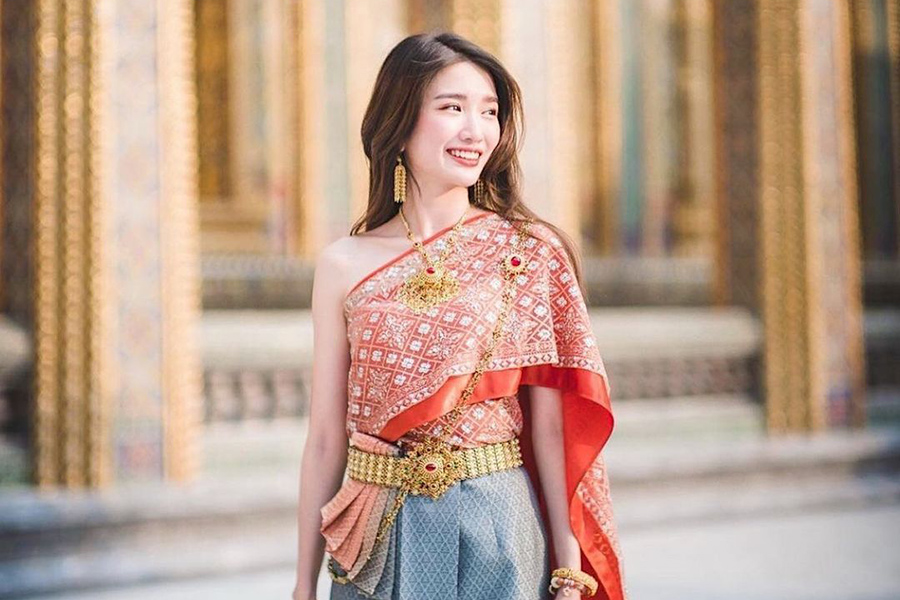
During vibrant festivals, Pha Biang takes center stage, transforming ordinary attire into a dazzling spectacle. Dancers twirl and sway, their Pha Biang fluttering like vibrant butterflies, adding a splash of color and energy to the festivities. In weddings, Pha Biang plays a pivotal role, adorning the bride and groom in hues that symbolize love, prosperity, and unity.
Pha Biang is more than just a piece of cloth; it is a tangible embodiment of Lao identity. It is a symbol of the people’s deep-rooted connection to their heritage, their appreciation for artistry, and their unwavering pride in their culture. Whether worn as a fashion statement, a practical garment, or a symbol of cultural significance, Pha Biang remains an enduring thread that weaves together the tapestry of Lao tradition.
Traditional costumes of Lao men
the salong – Laotian Men’s Traditional Clothing
Under the sun-kissed skies of Laos, where the Mekong River gracefully winds its way through verdant landscapes, lies a sartorial gem that proudly embodies the essence of Laotian masculinity – the Salong. This traditional garment, a symphony of vibrant hues and intricate designs, transcends mere attire; it is a symbol of cultural heritage, a testament to craftsmanship, and a timeless embodiment of the Laotian spirit.
The Salong, a word that resonates with the rhythm of Laos, is a large, loose-fitting trouser, meticulously crafted from silk or cotton, that dances around the wearer’s legs with effortless grace. Its origins can be traced back to the ancient Lan Xang Kingdom, where it was a symbol of nobility and refined taste. Today, the Salong remains a cornerstone of Laotian men’s attire, seamlessly blending into cultural celebrations, formal occasions, and everyday life.
The allure of the Salong lies not only in its historical significance but also in its captivating aesthetic. A kaleidoscope of colors adorns the Salong, each shade meticulously chosen to reflect the wearer’s personality and the occasion. Intricate patterns, woven with the deft hands of skilled artisans, narrate tales of Laotian heritage and artistry, transforming the Salong into a canvas of cultural expression.
The versatility of the Salong extends beyond its aesthetic appeal. It serves as a practical garment, shielding wearers from the sun’s warmth or providing a comforting layer during cooler evenings. Its significance extends even further, as the Salong is often exchanged as a token of respect or affection, a tangible expression of Laotian hospitality and goodwill.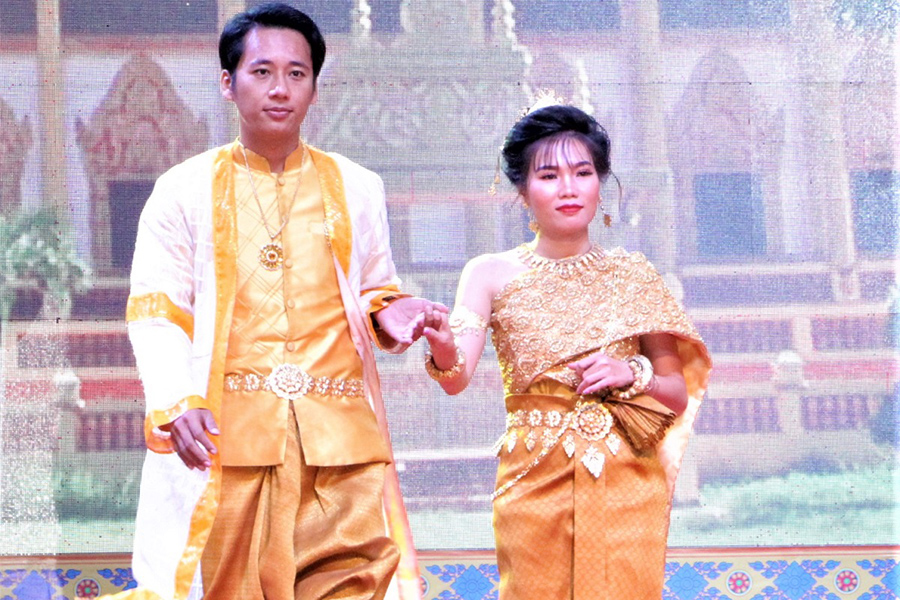
During vibrant festivals, Salongs take center stage, transforming ordinary attire into a dazzling spectacle. Dancers twirl and sway, their Salongs fluttering like vibrant banners, adding a splash of color and energy to the festivities. In weddings, Salongs play a pivotal role, adorning the groom in hues that symbolize prosperity, unity, and the promise of a harmonious future.
The Salong is more than just a piece of cloth; it is a tangible embodiment of Laotian identity. It is a symbol of the people’s deep-rooted connection to their heritage, their appreciation for artistry, and their unwavering pride in their culture. Whether worn as a fashion statement, a practical garment, or a symbol of cultural significance, the Salong remains an enduring thread that weaves together the tapestry of Laotian tradition.

